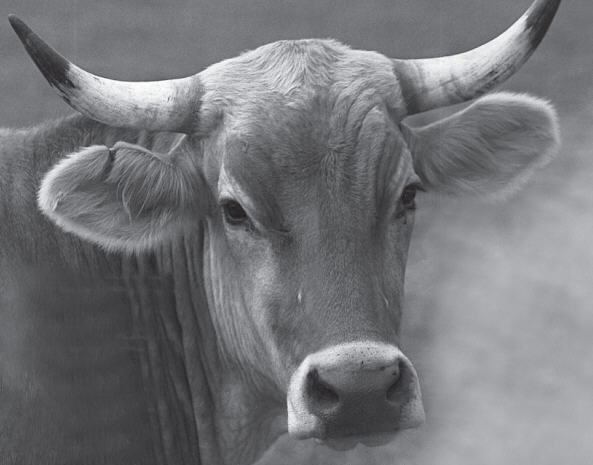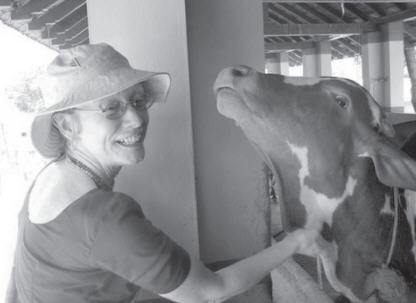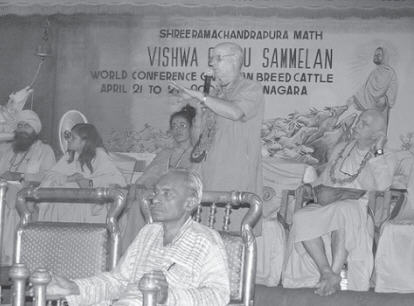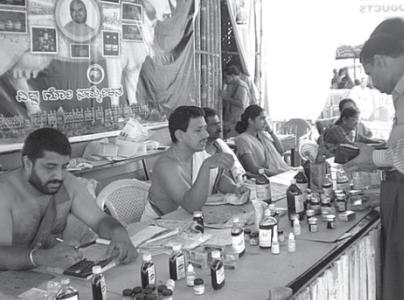A team of devotees visit 'Vishwa Gau Sammelana conference on cow protection
My husband Balabhadra and I incorporated ISCOWP, The International Society for Cow Protection, in 1990. His Divine Grace A.C. Bhaktivedanta Swami Prabhupada, our spiritual master, inspired us to give protection to cows throughout their lives so they may live a peaceful life away from the butcher's knife.
The actual philosophical reason for cow protection is very simple; all living entities deserve protection from slaughter and other violence at the hands of humans. Not only cows, a ll animals have souls, the same as we do. They are all children of Krsna, all dear to Him.
With this view in mind, slaughter is a form of MURDER.
The cow, however, is our MOTHER. Vedic philosophy teaches there are seven mothers: 1) the birth mother, 2) the nurse, 3) the wife of the father (if she is not the birth mother), 4) the wife of the king, 5) the wife of the spiritual master, 6) the earth, and 7) the cow. You may wonder why the cow is one of the seven mothers. It is because she gives her milk to nourish us.
All mothers should hold a position of respect, and since one does not kill and eat on e's mother, the cow should not be killed and eaten. Likewise, the bull is our father because he can plough the earth to produce food grains. One does not kill and eat one's father and mother not even when they are old and economically less useful.
ECONOMY OF COWS

5000 years ago, Lord Krsna, the Supreme Personality of Godhead, appeared on the earth to protect His devotees and to demonstrate His pastimes. Among those pastimes was His childhood role as a cow- herd boy. The cows were very dear to Him because of their affectionate and ge ntle nature as well as their contributions to human society, and He was kind to them in return and protected them. We should follow His example.
In contemporary practice the first principle of cow protection, surprisingly, is ox employment.
There is a mistake made when only the cow is considered, because typically, her main usefulness is seen as milk production, and she will not give milk unless she first has a calf. Half of all calves are bulls who will never produce milk. The expense of feeding the bulls will be a deficit to the farmer unless he realizes their potential for alternative en ergy by employing them in tilling the fields and hauling. Otherwise, the farmer, in most countries throughout the world, acquires his economic profit by selling them for meat.
The cow is also sold for meat when she cannot produce the required quantity of milk. Regardless of milk production, the dung and urine of a cow or bull is valuable. Instead of slaughtering all bovines that do not produce milk, why not utilize their dung and urine in fertilizers, compost, pest repellent, medicines, cleaning products, pancagavya, and biogas fuel to name a few useful and saleable items?
"Now, practically, in India they accept it, and it has been found by chemical examination that the cow dung contains all antiseptic properties. That is a fact. One Dr. Goshal, he a n a lyzed in his laboratory, "Why this Vedic injunction is the stool of cow or cow dung is pure!" So he analyzed, and he found it that the stool of cow, cow dung, is full of antiseptic properties." (Srila Prabhupada Srimad-Bhagavatam Lecture 7.9.10 9 July 1968 Montreal)

The modern system of agriculture does not realize the alternative energy potential of the bull calf nor the variety of useful bovine dung and urine products. Therefore, slaughtering becomes the only economically viable means of management. Most people, accustomed to this viewpoint and seeing no alternative, will throw up their hands and agree, even if they prefer a less violent solution. This is only because they don't have the facts. They don't know that the overall value of the ox is greater when he is utilized for work than when he's slaughtered for meat, and even when not productive a cow or ox produces useful urine and dung.
While in India my husband received an invitation from Mr. Sadashi v Montimar to attend the 'Vishwa Gou Sammelan', a huge cow conference that his guru, Shree Raghaveshwara Bharathi Swamaji, the guru of Shree Ramachandrapura Math, was sponsoring in South India. "It is a nine day conference on all aspects of cow protection," my husband wrote to me. "They are expecting half a million people to attend over the nine days. The conference is from April 21-29 in Hosanagara" India. I think it is worthwhile. "
After much debate, we decided to attend the conference with the main purpose of representing Srlla Prabhupada in his country of origin amongst his countrymen. As his American disciples, we would give credence to the power of his teachings. We hoped to attain contacts for spreading cow protection, and gain knowledge of cow care, particularly the use of cow dung and urine for medicines and the efficacy of these by products.
VISHWA GAU SAMMELAN
"Hare Rama! Gou Mata! Hare Rama! Gou Mata!," was chanted by a crowd of the math's disciples as we arrived at the Shree Ramachandrapura Math late at night on April 20. We replied, "Hare Krsna! Hare Rama!" Then they chanted back, "Hare Krsna! Hare Rama! Gou Mata!" It was such a spiritually potent beginning to an experience of a lifetime.

Balabhadra Dasa Speak At The Conference
Shree Raghaveshwara Bharathi Swamaji has dedicated himself to the preservation of the indigenous breeds of Indian cows. Nor only did he inspire the organization of the Sam mel an but many other social, educational, cultural, and environmental programs, many based on protection of the cow. One example is their Goubank that gives Indian cattle to people on the condition that they will not sell them, cross breed, or adopt artificial insemination. The bank accepts cattle as deposit when farmers find it difficult to maintain them. Not only does this help the rural farmer but also helps Swamiji achieve one of his objectives, which is to educate the Indian farmers and general public about the benefits of rearing and protecting Indian cows.
Lectures were given throughout the nine day conference by scientists, doctors, lawyers, farmers, cow protectors, activists, and other experts from around the world presenting their knowledge and understanding of cow protection. Some of the topics: scientific research, analysis, and utilities of cow urine; medicinal values of Indian breed cattle related products; role of indigenous cattle in organic agriculture; relevance of bullock draught power in Indian agriculture and rural transport; and opportunities for cow related products as an industry.
Approximately 200 acres housed the Sammelan in which there were not only scholarly presentations on many aspects of cows, but also a display of all the 27 Indian breeds that they are protecting and breeding in an effort to preserve the Indian cattle. Besides this were displays of; ox powered machines and equipment, household items run on cow urine, cow urine and dung medicinal and beauty products, art work about the cow in the form of paintings and sculpture, plays, music, and other forms of entertainment centered on the cow.
Our tour guide and president of the Ra:machandrapura Math, M.K. Janardan, showed us ISKCON KnI:la painting reproductions in the exhibition hall. He explained how they recognize Lord Krsna as a cowherd boy and an example to be followed. After the 'Vishwa Gou Sammelan ended, S hree Raghaveshwara Bharathi Swamaj i announced the building of the world's tallest statue of Lord Krsna in front of the Math in appreciation of the event's success.
Balabhadra gave two lectures, one before a thousand people, and one that received acclaim. He emphasized Srila Prabhupa:da's vision of cow protection. "Absolutely extraordinary speech," said Sunil Mansingha, chairman of one of the symposium sessions. "First time only a speech for the spiritual aspect of cows. I feel so encouraged due to your enlightenment." Mr. Mansingha is also the coordinator of the Govigyn Anusandhan Kendra in Nagpur, which is an organization that conducts scientifc research on the efficacy and use of cow dung and urine in medicines and other products. Later, Balabhadra received an award for his sp iritual contribution.

Balabhadra encouraged devotees from various ISKCON farms to attend the conference so they may absorb a ll the information available. Some of the devotees that attended were Govindanandana Da:sa and Radha: Kanta Da:sa from the ISKCON Hungary farm and Hrimati and Dr. Nanda Krsna from ISKCON Mayapur, India. Balabhadra and the devotees that accompanied him received much press coverage. "Cow Protection, ISKCON fully behind," was a translated title quote of one article that appered in several newspapers after a 30 minute press conference which featured Balabhadra showing his arm tattoos of an Indian cow and Lord Nityananada's lotus feet. Ra:dha: Kanta, Govindanandana, and myself appeared in several newspapers as, "experts from Hungary and USA, who have forayed into the field of cow protection and organic farming." We even had persons coming up to us reporting they had seen us on TV and asking for our autograph! We were pleased to be representing Srila Prabhupada, Lord Krsna, and the importance of cow protection.
We left the 'Vishwa Gou Sammelan' once again reminded of the Indian cutlure in which the majority of the population consider the cow as sacred and not just meat for their hamburger. To present cow protection in the west where the majority of people eat cows on a daily basis is a challenge that was greatly helped by the association of thousands of people who came to the Ramachandrapura Math to honor the cow. Lord Krsna showed us by His example, while as a young cowherd boy in Vrndavana 5000 years ago, how protecting cows is most important.
"From the Lord's personal activites, human society should learn how to give protection specifically to the brahmanas and cows. Then the protection of religious principles, fulfillment of the aim of life and protection of the Vedic knowledge can be achieved. Without protection of cows, brahminical culture cannot be maintained; and without brahminical culture, the aim of life cannot be fulfilled." Srimad-Bhagavatam 8.24.5 purport ~
Chaya Devf Das! was initiated by Srrla Prabhupada in 1971. She and her husband Balabhadra Dasa incorporated the International Society for Cow Protection (ISCOWP). Her husband is the ISKCON Minister for Cow Protection and Agriculture. They have dedicated their lives to the cause of cow protection and presently live on the 165 acre ISCOWP farm in rural West Virginia USA.
